|

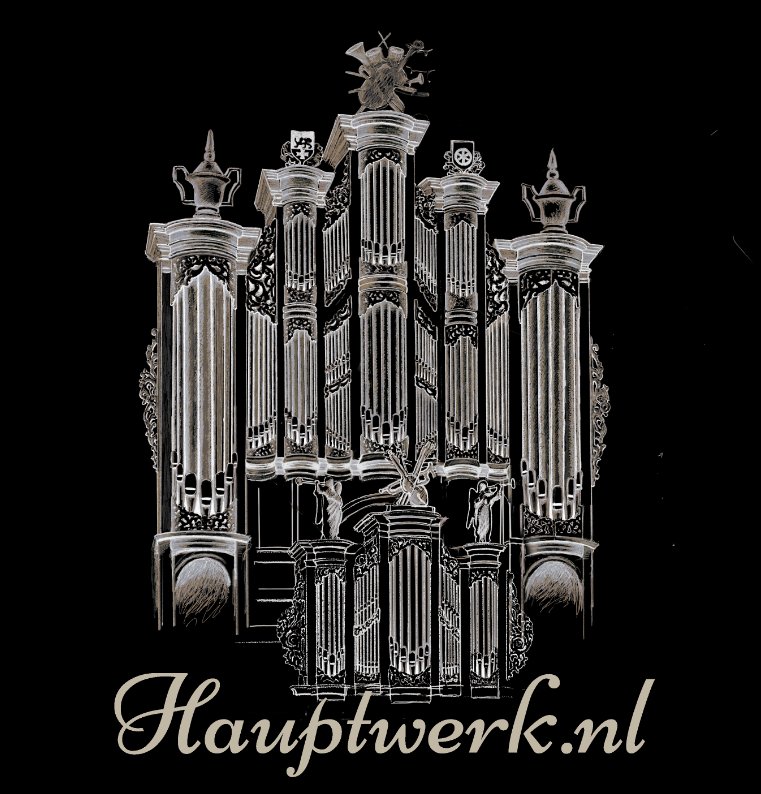









|
A short history of the church and the organ of Krewerd.
The church.
Krewerd, did you ever hear about this village in the Dutch province of Groningen?
It is hidden behind bigger places like Appingedam and Loppersum. Only people who really do their best can find it,
because the way to Krewerd leads via craggy bends. However, past the village of Jukwerd you suddenly spot the church of
Krewerd on its high mound.
When you keep that in sight you will not get lost anymore. Your effort has not been in vain.
It will be richly rewarded when you enter the village and see the sturdy Roman Gothic church in front of you.
|
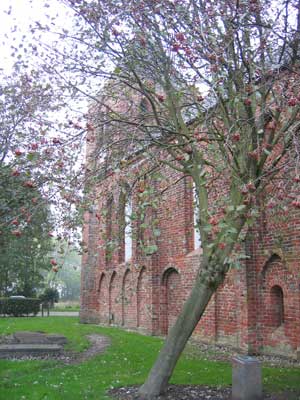
|
Gedicht van stain
D'r is in 't haile Noorden
Gain mooier ding veur mie
As 'n stoere bakstain kerke,
En 'n toren stoef d'r bie.
Zo'n toren braid en vairkant,
Mit'n dak as van 'n hoes,
Stait, rustig-roege haimhond,
Midden in 't windgebroes.
De muren binn'n grainmaank
Van stainen, klain en groot,
Bie zett'n grauw en soetrig
Moar mainstied gluiend rood!
En Voader Tied poestte over
Hail dit gedicht van stain
Glorie en glaans van d'aiwen:
Gain preek zo daip, gainain!
Onbekende dichter
|
Poem in stone
There is in the whole north
Nothing more beautiful to me
Than a sturdy church of brick,
And its tower nearby.
Such a tower large and square,
With a roof like one of a house,
Stands, quiet rough watchdog
In the middle of de rustle of the wind.
The walls inside are made of pine
From stones, small and large,
Sometimes grey and grubby
But mostly burning red!
And Father Time has polished
This whole poem in stone
Glory and gloss of centuries:
Not a sermon so deep, not one!
Unknown poet
|
There is a beautiful book about the history of Krewerd and its church written by Mrs. Sevenster-Meuter.
In that book we learn that in former times the sea flooded freely over the land because there were no protecting
dikes and dunes. People created mounds from salt marshes, waste and manure, at first for their private use.
Later on they connected the hills in cooperation with their neighbours. Because of that the mounds became still
bigger and higher.
People protected themselves this way and also their cattle and houses.
When they built a church people wanted it to be situated in the centre of the mound,
the highest location. It had to be a dry, sheltered place, as safe as possible for people and animals during times of floods.
Tiadeke from Krewerd.
There is a story about the noble lady Tiadeke from the village of Steenhuizerborg who prayed in the year 1250
to the Lord because her only son was very ill:
"O Lord, I promise to have a church built on my own ground if he may survive", she begged.
Her son recovered but Tiadeke did not keep her promise.
After some years her son died. Tiadeke remembered her old pledge and had a church built in Roman style.
Around 1280 it was finished. It was a building with a solid base and thick walls. It did not have an inflammable wooden roof,
but beautifully constructed round melon vaultings.
From her house Tiadeke must have followed the construction of the church.
The tower was built much later, in the 15th century; it was in very good harmony with the church.
All of us, especially the people of Krewerd can be grateful for this edifice, which is still in very good condition.
A building which speaks a clear language about life and death, about trouble and struggle,
but especially about perseverance and overcoming.
The isolated location of the more then seven centuries old church has probably been a matter of great luck for its survival.
Often there were turbulent times because of war, but they left Krewerd alone and the church stayed conserved.
Only time marked the building during the ages. Fortunately throughout history alert people took care of the restoration of
their precious church. Otherwise it would certainly not have been in such a good condition nowadays.
The simple interior of the Roman church, the old-fashioned oil lamps and especially the immense silence give
the entire area a distinctive character. One feels here withdrawn from daily life.
Source: Memories and old stories, written by D. Sevenster-Meuter
(with permission of the daughters Sevenster and Publisher Hoekstra)
The organ
|
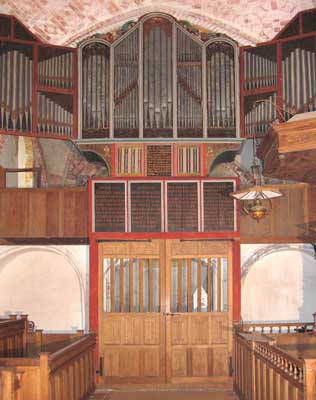
|
Upon entering the church, the organ immediately draws attention.
Because of the grey patina and the weather-beaten tin of the front pipes the organ radiates an
impressive and long history.
The organ, from an unknown builder, goes back to 1531. It is one of the most ancient still playable organs
of the Netherlands.
A curiosity of the organ are the panels on the left and the right sides. The painted pipe work dates from 1634.
|
Text on the middle panel under the organ:
|
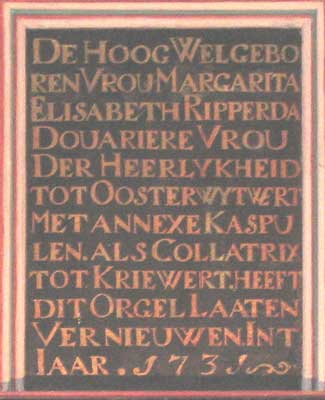
|
DE HOOG WELGEBO
REN VROU MARGARITA
ELISABETH RIPPERDA
DOUARIERE VROU
DER HEERLIJKHEID
TOT OOSTERWYTWERT
MET ANNEXE KASPU
LEN ALS COLLATRIX
TOT KRIEWERT HEEFT
DIT ORGEL LAATEN
VERNIEUWEN IN 'T
JAAR 1731
|
The text on the lower panels tells the history of repairs.
|
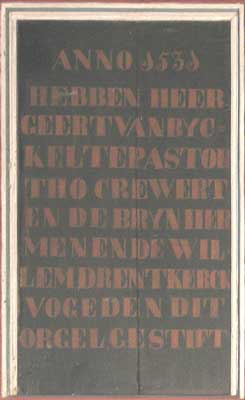
|
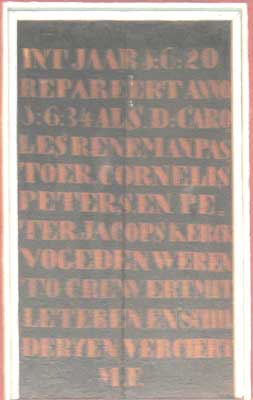
|
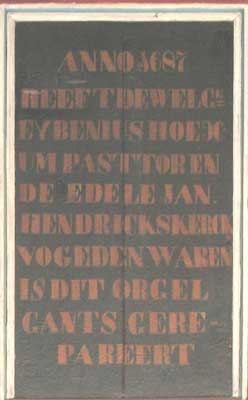
|

|
Paneel 1:
ANNO 1531
HEBBEN HEER
GEERT VAN BYC
KELTE PASTOR
THO CREWERT
EN DE BRUYN HER
MEN ENDE WIL
LEM DRENT KERCK
VOGEDEN DIT
ORGEL GESTIFT
|
Paneel 2:
IN HET JAAR 1620
REPAREERT ANNO
1:6:34 ALS D.CARO
LES RENEMAN PAS
TOER CORNELIS
PETERSEN EN PE-
TER JACOPS KERCK
VOGEDEN WEREN
TO CREWERT MET
LETEREN EN SCHIL
DERYEN VERCIERT
M.F.
|
Paneel 3:
ANNO 1687
HEEFT DE WELGB.
EYBENIUS HOEX
UM PASTTOR EN
DE EDELE JAN
HENDRICKS KERCK
VOGEDEN WAREN
IS DIT ORGEL
GANTS GERE-
PAREERT
|
Paneel 4:
IN HET JAAR 1857
IS DIT ORGEL BE
LANGRIJK GERE
PAREERD.PREDI
KANT WAS DE HEER
N.H.KUIPER KERK
VOOGDEN WAREN
P.h.BODE J.H.BOEK
HOUDT P.W.VOS
OUD KERKv.W.D.BURE
MA EN H.F.DE MAAR
ORGANIS W.S.MEYER
|
Periods of change
About the times of change one can only guess.
A mention on one of the panels at the front of the organ ín 1:6:34 "met leteren en schilderyen verciert"
makes the claim that the hatches have been painted/restored in 1634.
According to the text "dit orgel gants gerepareert" the organ would have been totally renovated in the year 1686.
In 1731 Nicolaas Willenbroek was ordered by noblewoman Ripperda to install a new C and Cis wind chest
with corresponding mechanism and manual.
Willenbroek was a fellow worker of Franz Caspar Schnitger who died in 1729.
In 1775, 1807 and 1844 major "dry repairs" were carried out by Lohman.
In 1857, Freytag constructed three big pine bellows and the corresponding wind trunk.
The oak channel to the chest had to be increased in size. To situate these bellows behind the organ the bay
of the choir was largely covered with a balcony.
Freytag replaced also the Quint 1 ½ ft bas/ Sesquialter 2 ranks discant by a stopped Flute 4 ft and the
Mixtuur 4-5-6 ranks by a Gamba 8 ft discant.
In 1974/1975, restoration by organ builder Albert Hendrik de Graaf.
Repair of the leaking wind chest without altering the original construction. New switches and nameplates.
Restoration of the manual and the pedal. Restoration of some damaged pipes.
Change of the Gamba discant by a Sesquialter 2 ranks discant.
In agreement with the restorers of the church the bellows in the SE-corner of the choir were situated on the ground floor.
The organ of Krewerd survived several wars and floods; however in 1967 the final curtain seemed to fall.
The state of the church building was abominable. People even spoke about demolition of the building and the selling of the organ.
But the church warden of the independent Dutch Reformed Community Krewerd,
farmer Marten Alje Bos protested fiercely against this threat.
And with success. Bos was supported by others, including the mayor at that time, Mr. Brons.
Church and tower were restored by Monumentenzorg (monument care). Organ builder/restorer Albert Hendrik de Graaf
(* reference footnote to biography of Mr. De Graaf) took very good care of the organ.
He writes:
From 1968 onwards they put the organ in my care. I was allowed to mend the instrument during the period of 1972-1975.
This restoration had a preservation intention. It was very important that the sound was not going to be damaged.
It seemed to be better to replace the pipes without alteration, after restoration of the wind drawer.
In only a few cases were repairs unavoidable.
The pitch,
The pitch is now (2006) more then one semitone higher then a=440 Herz.
Specification
The specification has been unchanged, from the renewal in 1731, with the exception of the Mixture and Sesquialter, removed in 1857.
The ages-old gothic organ with its maximum of resonance and volume and also with the very attractive radiant voices
is from a rare and rugged sort of beauty.
It's a miracle that in the remote landscape of Groningen this precious trinket in the old church of Krewerd
has been preserved during all these years.
Source: The organ in the church of Krewerd., Albert Hendrik de Graaf
Local Committee Krewerd of the "Stichting Oude Groninger Kerken".
1983 the church and tower are transferred to the "Stichting Oude Groninger Kerken".
|
|
This page has been translated by Sophie Visser®.
|
|
Corrections by John Coenraads®.
|
|
|
|
Hauptwerk.nl is een initiatief van Sygsoft Holland. Inschrijving KvK 93602855. Laatst bijgewerkt
20-04-2024
|
|
|